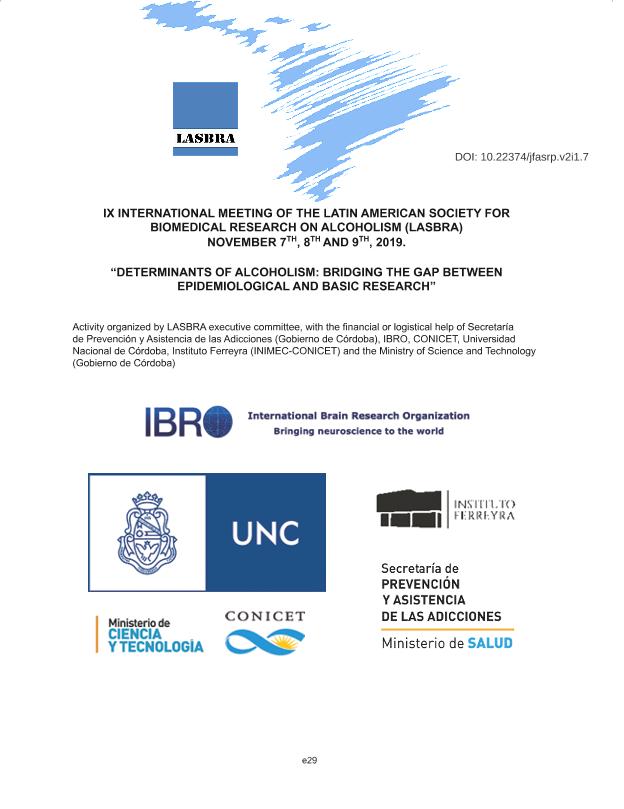Evento
Differences in marijuana outcomes as a function of sex and frequency of use
Castaño, Georgina; Herrera, Agustín; Gatti, Azul; Rivarola Montejano, Gabriela Belen ; Michelini, Yanina Noelia
; Michelini, Yanina Noelia ; Pilatti, Angelina
; Pilatti, Angelina
 ; Michelini, Yanina Noelia
; Michelini, Yanina Noelia ; Pilatti, Angelina
; Pilatti, Angelina
Tipo del evento:
Reunión
Nombre del evento:
IX International Meeting of the Latin American Society for Biomedical Research on Alcoholism
Fecha del evento:
07/11/2019
Institución Organizadora:
Latin American Society for Biomedical Research on Alcoholism;
Universidad Nacional de Córdoba. Instituto Ferreyra;
Título de la revista:
Journal of Fetal Alcohol Spectrum Risk and Prevention
Editorial:
Dougmar Press
Idioma:
Inglés
Clasificación temática:
Resumen
Marijuana is the most extensively used regulated drug in the world. Prevalence of marijuana use peak in emerging adulthood and, particularly, during college years. Heavy marijuana use is associated with a broad myriad of negative consequences (lower academic achievement, increased rate of dropout, risky sexual behavior). Traditionally, men have exhibited a greater prevalence of marijuana use than women. The present study examined the occurrence of marijuana use and marijuana-related negative consequences (NC) in a sample of Argentinean college students (n = 279, 75.6% women; M age = 23.02 ± 3.36 years). Specifically, we examined 1-differences in marijuana outcomes (i.e., prevalence and NC) as a function of sex and 2-differences in NC between high- and low-frequency users. Participants completed an online survey that measured frequency of marijuana use during the previous year and month and NC (assessed with the Marijuana Consequences Questionnaire [MACQ]). The MACQ is a 50-items scale grouped in eight subscales: Social-interpersonal Consequences, Impaired Control, Self-Perception, Self-Care, Risk Behaviors, Academic/Occupational Consequences, Physical Dependence, and Blackouts. Each item is scored dichotomously to reflect presence/absence of the NC. The total score reflects the total number of NC. We conducted X2 tests to examine the association between sex and prevalence of marijuana use. We applied the Student´s t-test to examine differences in NC as a function of sex and frequency of marijuana use. Results: Marijuana use was highly prevalent with 46.6% and 33% exhibiting last year and last month use, respectively. Men and woman exhibited a statistically similar frequency of marijuana use. Findings suggest that men and women exhibited statistically similar NC in all, but self-perception (t = 2.26(128); p ≤ .05; men more NC), MACQ?s subscales. High-frequency, compared to low-frequency, users experienced a significantly higher quantity of NC in Impaired Control, Self-Perception, Self-Care, Academic/Occupational Consequences, and Physical Dependence. Discussion: The present findings suggest that frequency of marijuana use is similar between men and women; however, those students who reported higher frequency of marijuana use experienced a significantly higher number of NC. This information is relevant for early detection and/or intervention targeting college students at risk for developing problems associated with marijuana use.
Palabras clave:
MARIJUANA USE
,
SEX DIFFERENCES
,
COLLEGE STUDENTS
Archivos asociados
Licencia
Identificadores
Colecciones
Eventos (IIPSI)
Eventos de INSTITUTO DE INVESTIGACIONES PSICOLOGICAS
Eventos de INSTITUTO DE INVESTIGACIONES PSICOLOGICAS
Eventos(CIECS)
Eventos de CENTRO DE INVESTIGACIONES Y ESTUDIO SOBRE CULTURA Y SOCIEDAD
Eventos de CENTRO DE INVESTIGACIONES Y ESTUDIO SOBRE CULTURA Y SOCIEDAD
Citación
Differences in marijuana outcomes as a function of sex and frequency of use; IX International Meeting of the Latin American Society for Biomedical Research on Alcoholism; Córdoba; Argentina; 2019; 84-84
Compartir



